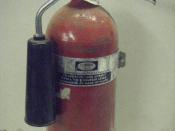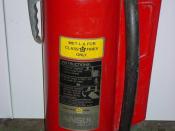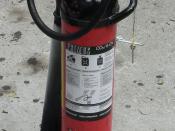Foam Stored Pressure Fire Extinguisher
Introduction
The fire extinguisher is a portable device used to put out fires of limited size. Such fires are grouped into four classes, according to the type of material that is burning. Class A fires include those in which ordinary combustibles such as wood, cloth, and paper are burning. Class B fires are those in which flammable liquids, oils, and grease are burning. Class C fires are those involving live electrical equipment. Class D fires involve combustible metals such as magnesium, potassium, and sodium. Each class of fire requires its own type of fire extinguisher.
Foam extinguishers use an aqueous film forming foam (AFFF) agent that expels a layer of foam when it is discharged through a nozzle. It acts as a barrier to prevent oxygen from feeding the fire. Although each class of fire has a specific extinguisher, the foam extinguisher is useful for both Class A and Class B fires; however, it is best suited for Class B.
This description explains to the general homeowner the structure, assembly, and operating principle of the foam fire extinguisher.
Fire extinguishers come in many sizes depending on the preference of the buyer. Foam fire extinguishers consist of a metal cylinder filled with an aqueous film forming foam usually under pressure of some form of non-flammable gas. A siphon tube directs the foam up through an assembly consisting of a handle and operating lever, which is secured during any period of non-use by a safety pin. The operating lever, when depressed, allows the foam to spray out of a hose connected to the siphon tube. Most extinguishers are replaced after a single use in order to assure dependability and to lessen the possibility of malfunction.
The foam fire extinguisher contains five interlocking parts:
*Safety pin
*Handle
*Hose
*Operating lever
*Siphon tube
(See Figure 1 on following page)
Figure 1 Parts of a foam stored pressure fire extinguisher.
Description and Function of Parts
Handle.
The handle is usually a solid, unmovable piece of metal that stretches horizontally above the cylinder. Attached securely to the metal cylinder, the handle is the part by which the fire extinguisher is meant to be carried and held while in use.
Operating Lever.
The operating lever is connected to the handle above and to the siphon tube below. After the safety pin has been removed, the operating handle can be depressed, allowing the foam inside to be released into the hose.
Safety Pin.
The safety pin is constructed of a durable metal and is intended to keep the operating lever from being depressed while not in use. The pin is intended to be removed before any use of the fire extinguisher.
Hose.
The hose is a piece of rubber tube approximately two to three feet in length. The hose is connected to the siphon tube through the operating lever. When the lever is depressed, it is through the hose that the foam is allowed to escape. During use, the operator must hold the hose in order to direct the foam spray.
Siphon Tube.
The siphon tube is a stainless steel rod approximately the same length as the cylinder. Located inside the metal cylinder, the siphon tube is connected to the operating lever. When the lever is depressed, the foam is powered up the tube by the pressurized gas and expelled through the hose.
Metal Container.
The metal container containing the extinguishing foam varies in size depending on how much liquid it holds. The typical household fire extinguisher usually contains approximately 2 liters of foam. The cylinder is constructed of several layers (See Figure 1). The outer layers are usually thin layers of fire resistant sheets. In the middle, the bulk of the cylinder is made of steel. The innermost layer is a thin sheet of aluminum that separates the steel core from the foam inside the container.
Summary and Operating Description
As described, the foam stored pressure fire extinguisher is quite simple in its design. Constructed from parts intended to make the extinguisher easy to use and also to allow the extinguisher to be safely kept in any household, the foam stored fire extinguisher is a necessary part of every home.
For safe recognition, all fire extinguisher use picture/labeling to designate which types of fires they are to be used on. Most fire extinguishers are labeled with colored geometrical shapes with letter designations. Although the foam stored pressure fire extinguisher can be used on both Class A and Class B fires, it is best used for Class B; therefore, it is most likely to be only labeled with the Class B shape and letter designation (Figure 2). However, some companies place both Class A (Figure 3) and Class B descriptions on the cylinder allowing users to know that it can be used for both classes of fires.
Figure 3 Class A fire labels. (Crown Fire Equipment)
Figure 3 Class B fire labels. (Crown Fire Equipment)
In the case of a Class A or B fire involving combustibles (such as wood, cloth, or paper) or liquids (such as oil or grease) the foam fire extinguisher is very useful. In an operating cycle, the fire extinguisher is picked up and held by the solid handle. After the safety pin is removed, the operating handle is depressed, allowing the foam inside the metal container to flow up the siphon tube and out of the hose to extinguish the fire.


